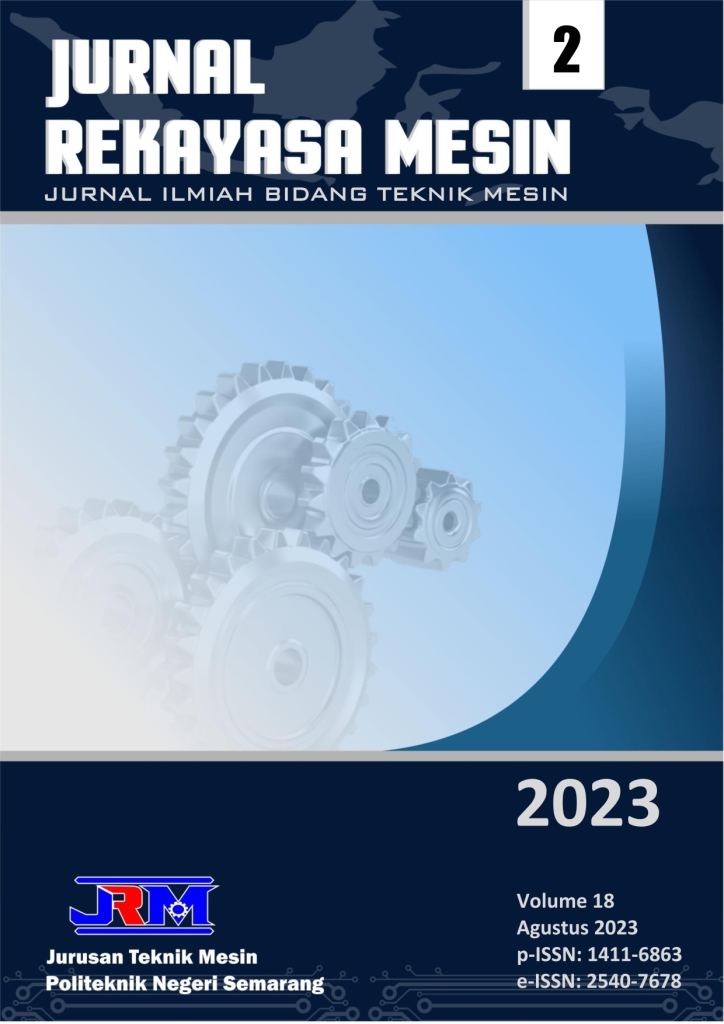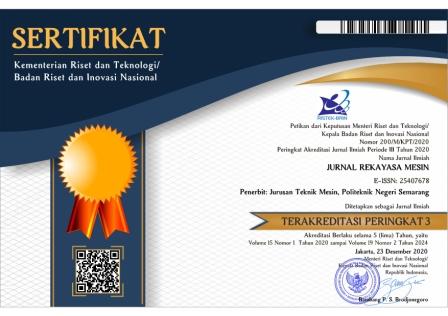Perancangan dan Analisis Konstruksi Mekanik pada Robot Pemadam Api Hexapod Menggunakan Metode Finite Element Analysis dan Inverse Kinematics
DOI:
https://doi.org/10.32497/jrm.v18i2.4017Keywords:
Hexapod Robot, SAR, FEA, Inverse kinematic, Von Misess StressAbstract
Fires often occur in dense urban areas, judging from their geographical location, urban areas that have dense populations which are areas prone to fire disasters which result in very difficult handling because the location is difficult to reach by fire engines. One of the countermeasures that can be done is by using a hexapod robot. In this research, the steps taken are by designing the mechanical construction of the robot using Autodesk Inventor Software and performing FEA analysis using Autodesk Inventor Stress Analysis Software, after that perform calculations and simulations of Inverse kinematic using RoboAnalyzer Software. The results obtained in this study are the dimensions of the hexapod SAR robot which is designed to have a total length of 145 cm, width 85 cm and height 85 cm, with a robot weight of 42.5 kg with a water tank capacity of 44.32 liters. The grip on the robot has a multifunctional type with a maximum load that can be lifted is 50 kg. The results of the inverse kinematic angle that can be used on the robot are coxa angle 0 °, femur 45 ° and tibia -135 °. In the FEA simulation, the largest von misess stress is 144.2 mpa and the largest safety factor value is 1.73 ul in the safe category. With the results of this study, it can be concluded that the robot can easily go in and out of the room during evacuation and has a safe construction design equipped with a strong grip in lifting loads and a flexible and efficient water sprayer.
References
D. F. Saraswati and A. B. Cahyono, “Analisis Daerah Risiko Bencana Kebakaran di Kota Surabaya dengan Menggunakan Sistem Informasi Geografis,” J. Tek. ITS, vol. 6, no. 2, pp. 1”“4, 2017,
J. A. Orosz, R. A. Remillard, C. D. Bailyn, and J. E. McClintock, “An Optical Precursor to the Recent X-Ray Outburst of the Black Hole Binary GRO J1655−40,” Astrophys. J., vol. 478, no. 2, pp. 1”“2, 1997,
E. Safrianti, R. Amri, and S. Budiman, “Prototype Robot Pemadam Api Beroda Menggunakan Teknik Navigasi Wall Follower,” J. Rekayasa Elektr., vol. 10, no. 2, 2012, doi: 10.17529/jre.v10i2.134.
M. . Dr. Hendra Jaya, S.PD., Sistem Robotika, vol. 300. 2016.
G. Firasanto, “PENGENDALIAN ROBOT HEXAPOD BERBASIS INTERNET OF THINGS ( IoT ),” J. Electr. Power, Instrum. Control, vol. 4, no. 1, pp. 1”“9, 2021, doi: 10.32493/epic.v4i1.9910.
S. Sukardi and S. G. Zain, “Pengembangan Algoritme Gerak Robot Hexapod Menggunakan Logika Fuzzy,” Jessi, vol. 02, no. May, pp. 44”“51, 2021.
P. S. Pa and C. M. Wu, “Design of a hexapod robot with a servo control and a man-machine interface,” Robot. Comput. Integr. Manuf., vol. 28, no. 3, pp. 351”“358, 2012, doi: 10.1016/j.rcim.2011.10.005.
Y. Qu, P. Durdevic, and Z. Yang, “Smart-Spider: Autonomous Self-driven In-line Robot for Versatile Pipeline InspectionâŽ,” IFAC-PapersOnLine, vol. 51, no. 8, pp. 251”“256, 2018, doi: 10.1016/j.ifacol.2018.06.385.
C. E. J. Mamahit, F. R. Seke, and H. Ponto, “Pengembangan Sistem Gerak Robot Berkaki Enam,” vol. 2, no. 1, pp. 53”“60, 2022.
E. Burkus and P. Odry, “Mechanical and walking optimization of a hexapod robot using PSO,” ICCC 2013 - IEEE 9th Int. Conf. Comput. Cybern. Proc., pp. 177”“180, 2013, doi: 10.1109/ICCCyb.2013.6617583.
S. Y. Misyurin, G. V. Kreinin, N. Y. Nosova, and A. P. Nelubin, “Six-Legged Walking Robot (Hexabot), Kinematics, Dynamics and Motion Optimization,” Procedia Comput. Sci., vol. 190, pp. 604”“610, 2021,
L. Kang, J. T. Seo, S. H. Kim, W. J. Kim, and B. J. Yi, “Design and implementation of a multi-function gripper for grasping general objects,” Appl. Sci., vol. 9, no. 24, 2019, doi: 10.3390/app9245266.
F. Sirait and B. A. Wicaksono, “Jurnal Teknologi Elektro, Universitas Mercu Buana ISSN : 2086 ” 9479,” J. Teknol. Elektro, Univ. Buana, vol. 8, no. 2, pp. 87”“94, 2017,
“Roboanalyzer user manual,” 2011.
M. A. Rozik, “Mesin Pengayak Pasir Menggunakan Autodesk Inventor 2019,” 2019.
Downloads
Published
How to Cite
Issue
Section
License
Copyright of articles that appear in Jurnal Rekayasa Mesin belongs exclusively to Penerbit Jurusan Teknik Mesin Politeknik Negeri Semarang. This copyright covers the rights to reproduce the article, including reprints, electronic reproductions, or any other reproductions of similar nature.







